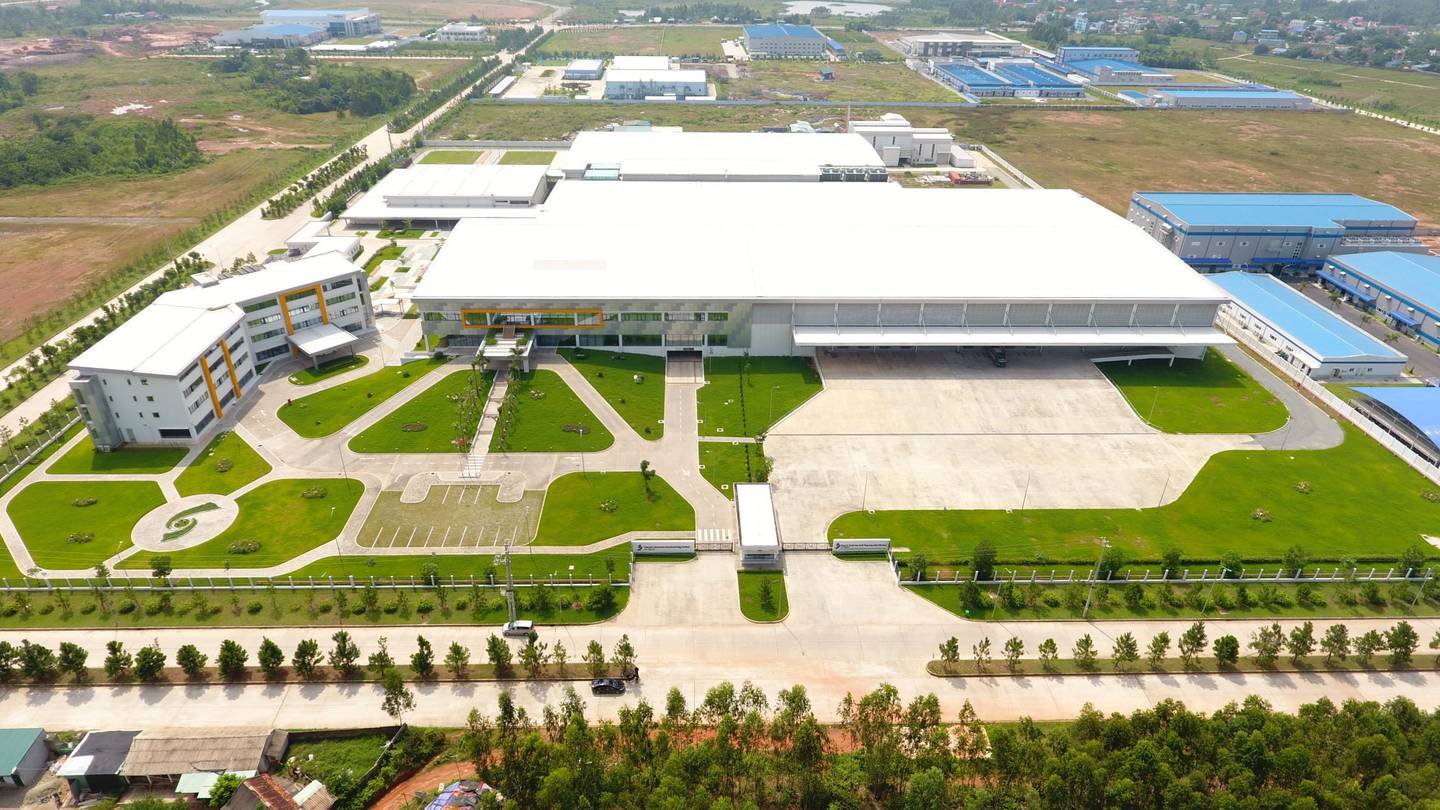
Joe Bidenâs visit to Vietnam in September was seen as an endorsement for American companies to up their already sizeable investments in the country. Though geopolitics and tech supply chains were top of the agenda, the US presidentâs visit also underscored the strategic importance of Vietnamese manufacturers to the global fashion industry.
âAs foreign and commercial policy seeks diversification from China⦠[Bidenâs] short visit did draw attention to Vietnam,â said Steve Lamar, president of the American Apparel & Footwear Association (AAFA). â[But] there already exists a strong foreign policy partnership between the [two countries].â
From 2018 to 2022, Vietnam ranked as the second largest exporter of textiles and apparel to the US after China, with value surging 54.9 percent over the period, according to the United States International Trade Commission.
âCompanies continue to explore how and if they should expand existing operations in Vietnam and, to the extent they are not already sourcing there, whether they should add Vietnam to their own sourcing mix,â Lamar added.
Yet some local factories are struggling to keep up with increasingly competitive players across Asia. âBangladesh has very low labour costs; the average pay is $80 [per month] versus $130 for Vietnamese,â said Vu Duc Giang, chairman of the Vietnam Textile & Apparel Association (VITAS).
VITAS estimates that labour and land rental costs for Vietnamese enterprises accounted for 32 percent of the total cost of textile products, compared to only 12 percent in Bangladesh and Cambodia.
According to the Vietnam National Textile and Garment Group, the industry lost 1.3 percent of its market share in the US in the first half of last year. It has also experienced a significant drop in orders from key import regions, including the US and EU, due to lower demand resulting from global economic headwinds.
Taiwanese footwear maker Pouyuen, a manufacturing contractor for Adidas, Nike and Reebok, laid off more than 8,000 workers in Vietnam over two rounds due to insufficient orders last year. Meanwhile, Garment Saigon Corporation, which had about 4000 workers in 2019, has since laid off thousands, according to local sources.
âMost companies in the industry either suffer from a shortage of orders or have to accept lower-priced orders to maintain production and retain workers,â said Tran Nhu Tung, chairman of the board at Thanh Cong Group, in the companyâs annual report 2022. The export-focused firmâs clients include Adidas, New Balance and Eddie Bauer.
But Lamar suggests that recent challenges havenât significantly dampened brandsâ interest in the country. âDespite capacity and production constraints that materialised during the past few years, Vietnam remains an important sourcing partner for apparel, footwear and travel goods,â he said.
For decades, Vietnam has been a primary manufacturing base for global apparel and footwear megabrands. Nike alone has more than 100 suppliers in Vietnam, with 96 plants concentrated in the southern region, according to Research and Marketsâ Vietnam Footwear Manufacturing Industry Report 2022.
âVietnam has experienced one of the strongest upticks in manufacturing and processing capacity in the world since the early 2000s,â said Leif Schneider, legal counsel at advisory Luther Vietnam and vice chairman of the Legal Sector Committee at the European Chamber of Commerce in Vietnam (EuroCham).
Overall, the country has approximately 6,000 garment and textile manufacturing companies employing 2.5 million people, with top export destinations being the US, Europe, Japan and South Korea. In 2022, exports reached $37.6 billion, increasing 14.7 percent year on year according to data from the Vietnamâs finance ministry departments.
From friendshoring to âChina Plus Oneâ strategies
In recent years, the country has seen a rise in fashion companies setting up production facilities as they sought to de-risk and diversify supply chains.
âThe main opportunities for companies sourcing from Vietnam lie in reducing costs and political risk vis-a-vis China,â confirmed Chris Rogers, head of supply chain research, S&P Global Market Intelligence.
Many firms wanted to reduce their dependency on China amid the growing friendshoring and nearshoring movements, seeing Vietnam as a way to pursue âChina Plus Oneâ (C+1) strategies with a neighbouring country. Even before that, companies sought sourcing alternatives in Vietnam due to rising labour costs in China.
âThe push for European market entry has gained further momentum since Vietnam entered a new stage of free trade agreement adoption,â explained Schneider.
The EU-Vietnam Free Trade Agreement (EVFTA), which came into effect in August 2020, has fuelled the investment wave from European companies into the country. âThe [agreement] paved the way for increased trade between the EU and Vietnam and aims to eliminate almost 99 percent of existing customs duties between member states,â he added.
A year after EVFTA was ratified, Danish outdoor sports apparel maker Spectre started construction on its third factory in An Giang province with an investment of about $17 million that created around 2500 local jobs. In 2022, Danish jewellery brand Pandora announced it was investing $100 million in a new facility in southern Vietnam â the firmâs first manufacturing site outside Thailand â which it said will create more than 6,000 jobs.
According to CBI, the Centre for the Promotion of Imports from developing countries, Vietnam ranked as the fifth largest apparel exporter to the EU last year after China, Bangladesh, Turkey and India, with an export value of â¬4.4 billion ($4.7 billion).
The country has signed about 15 free trade agreements, including the EU-Vietnam Free Trade Agreement (EVFTA), the UK-Vietnam Free Trade Agreement (UKVFTA), and the Comprehensive and Progressive Agreement for Trans-Pacific Partnership (CPTPP). Collectively, these have helped significantly boost the manufacturing sector.
The recent escalation of Sino-US geopolitical tensions and supply chain disruptions caused by the pandemic prompted some companies to see Vietnam in an even more favourable light.
Hong Kong-headquartered manufacturer TAL Apparel, whose customers include Brooks Brothers, Hugo Boss, Michael Kors, JC Penney and LL Bean, entered Vietnam 20 years ago. But in 2015, when the company opened its second factory in the country, Vietnam became TALâs largest production base.
âIf you think about where we were before, we had a third of our production in China, a third in Malaysia, and a third in Thailand⦠and Indonesia. They are all pretty high-cost countries,â said Roger Lee, CEO of TAL Apparel. âSo we [needed] to think where the next area we [could] go that will have lower labour cost for us to be competitive⦠The worker costs in China are three times more expensive than in Vietnam so Vietnam wins a lot on the cost side.â
The significant cost advantages allow companies to allocate more of their budgets towards other priorities such as research and development.
This helps explain why fashion companies from other Asian countries are also ramping up investment in the country. According to Nikkei Asia, since 2022, Japanese firms, including Adastria, Aoyama Trading and Matsuoka Corporation, a contract manufacturer for Fast Retailingâs subsidiary Uniqlo, have increased production in Vietnam and other Southeast Asian countries. Last year Japan overtook the EU as the second-largest importer of Vietnamese textiles and garments with about $3 billion in turnover
In recent years, the country has seen a wave of mainland Chinese factories opening subsidiaries and local units in industrial clusters. âVietnam is a more natural home for Chinese manufacturers given the close relations between the Chinese and Vietnamese governments,â Rogers explained.
Although Vietnam has not yet reached Chinaâs level of sophistication in supply chain technology and infrastructure, it is comparatively advantageous in other ways. âThere are benefits to being a late mover in that other companies have already paid to develop staff and corporate investments by suppliers in factories and logistics,â said Rogers
Lee has found other benefits in Vietnam compared to China. âThe difference lies in middle management [where]⦠we found that Vietnamese middle management has been very strong for us,â he said.
Vietnamâs stable political environment and economy have also contributed to investor confidence.
âVietnam had a long-term view of where they wanted to take the economy. They controlled the inflation rate very well. They controlled the wages very well. I think the government looks at what China does and tries to learn from its mistakes,â said Lee.
GDP growth in Vietnam slowed to 5.05 percent this year from 8.02 percent last year, weighed by falling exports and weak public investment amid an intensified anti-graft crackdown. Capital Economics forecasts that growth next year will swing back to 6.05 percent.
The countryâs strategic location in Southeast Asia offers convenient and cost-effective access to regional markets, further enhancing its appeal for companies looking to optimise the flow of inbound raw materials and components and outbound goods in their supply chains.
Potential operational risks and challenges
As a major exporter of textiles, Vietnam heavily relies on cotton imports from China to sustain its production, which creates significant risks for Vietnamese firms. Local supply chains have faced significant disruptions ever since the Uyghur Forced Labor Prevention Act (UFLPA) took effect in the US in 2022, restricting the use of cotton produced in Chinaâs Xinjiang region due to human rights concerns.
Other factors risk eroding Vietnamâs competitive advantages. Recent changes in the countryâs corporate income tax incentives could take some of the shine off local production. The two main incentives â tax holiday rates and preferential tax rates â have reduced the tax burden on businesses but Vietnamâs parliament announced late last year that it is set to apply a global minimum tax (GMT) rate of 15 percent from the beginning of this year.
That said, Vietnamâs major competitors for foreign direct investment in the region â Thailand, Indonesia and Malaysia â have also agreed to adopt the GMT.
Vietnamâs reputation as a country with a complex business culture has also discouraged some foreign companies from putting down roots. Even though it has almost fully integrated into the global capitalist system, Vietnam is still officially a single-party communist state operating what the government calls a socialist-oriented market economy.
âSimilar to other developing markets of Southeast Asia, Vietnam bears a certain risk potential associated with the relatively opaque legal framework provided for many foreign investment endeavours,â said Schneider. âTypical market entry procedures can be lengthy and face unforeseen obstacles on the way, which may require some resilience, flexibility and patience from foreign investors to reach completion.â
âWhile the regulatory situation is improving across most industries, propelled by Vietnamâs multilateral treaty commitments, some lingering roadblocks to the countryâs industrial development persist,â Schneider explained, citing âlengthy and unpredictable licensing procedures that often hinge on local authority discretionâ as a common challenge that companies must navigate.
âTo maintain its reputation as a favourable destination for regional and global manufacturing activities, Vietnam would be well-advised to keep improving its regulatory framework for foreign investment and become more administratively efficient,â he concluded.
Go green to sustain production levels
Experts have advised Vietnamese textile-garment firms to improve the sustainability credentials of their production lines to continue exporting to western markets like Europe. The EUâs Ecodesign for Sustainable Products Regulation (ESPR), which sets minimum design standards for products in terms of recyclability, durability, reusability, repairability and use of hazardous substances, is set to come into full effect next year.
âRecyclers are moving into Vietnam because thereâs an abundance of raw materials [resulting from waste as a manufacturing hub],â said Christina Dean, a sustainable fashion advocate who founded Hong Kong-based NGO Redress. â[But] what you need for a proper recycling value chain is the recycler⦠and spinners to spin the yarn. China, with a much more developed fashion and textile industry, has more advanced spinning technology. That part of the value chain is not as established in Vietnam as in China.â
The American market is also increasingly a challenge. According to Giang, about 80 percent of Vietnamâs textile and garment export businesses have been struggling with the US governmentâs recent implementation of green standards.
Still, the country has seen a shift to more environmentally friendly textile production with several manufacturers rolling initiatives to meet global demand.
South Koreaâs Hansae Group plans to open a new factory to produce recycled cotton fibre with circular fibre maker Recover in southern Vietnam. The group signed a deal with the Vietnam National Textile and Garment Groupâs subsidiary to develop a comprehensive distribution network from yarn to weaving, dying, and sewing, entirely for recycled goods.
Hansae, whose global clients include Gap, H&M and Zara, has its largest overseas production base in Vietnam, operating 10 Vietnamese corporations and 12 factories, and employs about 25,000 people nationwide.
Saitex, a Vietnam-based denim manufacturer that counts Everlane, J.Crew and Target among its clients, is known for its sustainability credentials. However, even as a B-Corp firm which designates it as a relatively high performer against certain metrics, Saitex has faced difficulties while building its reputation. Last year, about 300 workers went on strike after being penalised for mistakes that resulted in product defects.
Overall, worker welfare does not appear to be moving in the right direction, according to Verisk Maplecroftâs Modern Slavery (MSI) Index.
Vietnam rose from the 22nd to the 15th highest place in the index between Q4 2022 and Q4 2023. The firm considers this to be in the very high-risk category. By comparison, Indonesia ranked 30th and the US 130th in Q4 2024. InWalk Freeâs Global Slavery Index (GSI) 2023 cited a study on the Vietnamese garment industry which found that 6 percent of worker participants were likely in a situation of forced labour.
But every sourcing market comes with its own set of challenges, barriers and downsides, suggests Rogers. âDifferent countries have varying risks,â he said. âThe pandemic has taught us that multi-sourcing is the way ahead.â
Indeed, even with all of Vietnamâs strengths, it is too risky for apparel and footwear companies to put all their eggs in one basket, warned Lee. âAbout 65 percent of what we make is out of Vietnam. If I could, I would make it 80 or 90 percent. But then itâs a risk.â
Rogers said manufacturing in Vietnam will likely continue to expand over the next five years, but new challenges may emerge as costs rise and its advantages over competitor countries are eroded.
âLike all major sourcing [locations], Vietnam needs to continuously evaluate what its competitive advantage is,â said Lamar. âIt will need to prioritise its ability to support a more vertical industry, particularly as companies are looking to diversify tier two and three suppliers from China, and sustainable practices, such as greater use of renewable energy like solar and wind.â
âThis competitive pressure will only intensify as brands and retailers are also seeking to invest in new sourcing [locations]â¦throughout Asia, Africa, and the Western Hemisphere. While that dynamic will not affect Vietnam in the shorter term, it could pose significant competitive challenges in the medium to longer term,â Lamar concluded.



